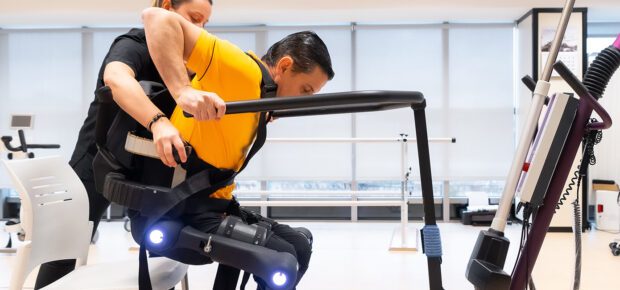May 18, 2023
Robotic exoskeletons, the power-augmented wearable devices, are transforming industries and lives. In warehousing and logistics, these wearable robotic suits offer workers a powerful assist in lifting heavy objects, enhancing productivity and reducing risk of injury. Moreover, the interest in developing robotic exoskeletons for people with limited mobility is rapidly growing, heralding a new era in assistive technology.
IEEE Member Ayonga Hereid is part of a team developing cutting-edge bipedal, or two-legged, exoskeletons for people who do not have use of their legs. He said that current exoskeleton designs often depend on crutches or similar devices to maintain stability, a limitation that restricts users who aspire for more independent movement.
Hereid aims to transcend this limitation.
“Our goal is to deepen our understanding of how these robotic exoskeleton systems function,” Hereid said. “By doing so, we aim to pave the way for future breakthroughs in the field of robotics and ultimately enhance the lives of those who depend on these devices.”
In this recent interview, Hereid provides insight into the current state of robotic exoskeleton technology and discusses ongoing research into how control theory and robotics can aid exoskeletons in achieving natural and efficient movements.
Developing robotic exoskeletons involves a number of areas of expertise – mechanical engineering, software engineering, electrical engineering and human physiology all come into play. Can you describe your area of research and expertise?
My research primarily focuses on advancing motion planning and control algorithms for lower-limb robotic exoskeletons. Specifically, I investigate the development of synchronized joint motions that can be accurately tracked through feedback controllers to achieve stable and robust locomotion. This involves exploring ways to generate stable movements in lower-limb exoskeletons while ensuring smooth and safe transitions between different activities.
What motivates you to pursue this area of research?
These devices have the potential to significantly improve mobility and quality of life for people with mobility impairments.
We’re particularly interested in adapting state-of-the-art locomotion controllers for bipedal robots to lower-limb exoskeletons. By pushing the boundaries of what’s possible with exoskeleton technology, we hope to make a real impact on the lives of people who rely on these devices, empowering them to move more freely and confidently in their daily lives.
How does the lack of wheelchair accessibility influence the pursuit of bipedal exoskeletons?
One of the main reasons we’re pursuing this technology is to provide an alternative to traditional wheelchairs, which can be difficult or impossible to use in certain environments. But it’s also important to recognize that bipedal exoskeletons won’t completely replace wheelchairs. They may not be able to match the comfort and speed of wheelchairs, especially for users who have severe mobility impairments.
Of course, improving wheelchair accessibility should remain a top priority, as it’s essential for creating more inclusive and equitable societies. By combining efforts in infrastructure development and technological innovation, we can work towards a future where everyone has access to the mobility tools and support they need to lead fulfilling lives.
Are bipedal exoskeletons being used now?
There are several companies that are actively working to commercialize bipedal exoskeletons, and some of their products have received FDA approval for use in clinical settings.
What are the barriers to widespread adoption right now?
Widespread adoption of these devices outside of clinical settings is still limited.
One of the main barriers is the maturity of the technology. While there have been many success stories of using bipedal exoskeletons with close assistance from clinicians and technicians, their reliable use outside of these controlled settings is still limited. For example, these devices may not perform as well in uneven terrain or in busy environments, where users need to react quickly to changing situations. There is a need for further research and development to ensure that these devices are safe and effective for use in real-world situations.
Another obstacle to widespread adoption is the high cost of current exoskeletons. Many people with disabilities may not be able to afford these devices, and insurance coverage for exoskeletons is often limited or non-existent. Additionally, some users may find the weight and bulk of exoskeletons to be a challenge, as they can limit mobility and cause discomfort over extended periods of use.
How do users react to the use of exoskeletons, either in tests you’ve done or in the real world?
While there are still challenges to overcome, users’ reactions to exoskeletons have been largely positive. Most users who participated in the clinical trials were excited about the potential of being able to walk again. While there are some concerns regarding the affordability, safety, convenience and flexibility of using exoskeletons at home or in real-world settings, most participants were satisfied with the experiences.
There are some exoskeletons that seem to be used in warehouse and logistics settings. How does the design of those differ from exoskeletons for people who do not have use of their legs?
Warehouse exoskeletons are designed to support human operators in lifting and carrying heavy objects. Exoskeletons for people who do not have use of their legs focus on assisted locomotion. Warehouse exoskeletons typically only have upper body components, using passive or powered mechanisms to assist with back support or arm movements. Some full-body exoskeletons are designed to provide both manipulation and locomotion assistance.
These exoskeletons tend to be bulkier than lower-limb exoskeletons for people with spinal cord injuries, as their tasks require more powerful motors. Workers using warehouse exoskeletons do not need to be tightly strapped to the operator’s body, as the operator can sufficiently support their own body movement. This reduces the effective physical interactions between the device and the user, thereby reducing the complexity of the electro-mechanical design of such exoskeletons.
Learn more: Several technologies are converging to make prosthetic limbs more responsive, resilient, and user-friendly. The IEEE Engineering in Medicine and Biology Society’s Pulse shows how there is a new era in bionic limbs.






 Liquid Infrastructure: Our Planet's Most Precious Resource
Liquid Infrastructure: Our Planet's Most Precious Resource The Impact of Technology in 2025
The Impact of Technology in 2025 Quantum and AI: Safeguards or Threats to Cybersecurity?
Quantum and AI: Safeguards or Threats to Cybersecurity? Why AI Can't Live Without Us
Why AI Can't Live Without Us Bits, Bytes, Buildings and Bridges: Digital-Driven Infrastructure
Bits, Bytes, Buildings and Bridges: Digital-Driven Infrastructure Impact of Technology in 2024
Impact of Technology in 2024 Emerging AI Cybersecurity Challenges and Solutions
Emerging AI Cybersecurity Challenges and Solutions The Skies are Unlimited
The Skies are Unlimited Smart Cities 2030: How Tech is Reshaping Urbanscapes
Smart Cities 2030: How Tech is Reshaping Urbanscapes Impact of Technology 2023
Impact of Technology 2023 Cybersecurity for Life-Changing Innovations
Cybersecurity for Life-Changing Innovations Smarter Wearables Healthier Life
Smarter Wearables Healthier Life Infrastructure In Motion
Infrastructure In Motion The Impact of Tech in 2022 and Beyond
The Impact of Tech in 2022 and Beyond Cybersecurity, Technology and Protecting Our World
Cybersecurity, Technology and Protecting Our World How Technology Helps us Understand Our Health and Wellness
How Technology Helps us Understand Our Health and Wellness The Resilience of Humanity
The Resilience of Humanity Harnessing and Sustaining our Natural Resources
Harnessing and Sustaining our Natural Resources Creating Healthy Spaces Through Technology
Creating Healthy Spaces Through Technology Exceptional Infrastructure Challenges, Technology and Humanity
Exceptional Infrastructure Challenges, Technology and Humanity The Global Impact of IEEE's 802 Standards
The Global Impact of IEEE's 802 Standards Scenes of our Cyber Lives: The Security Threats and Technology Solutions Protecting Us
Scenes of our Cyber Lives: The Security Threats and Technology Solutions Protecting Us How Millennial Parents are Embracing Health and Wellness Technologies for Their Generation Alpha Kids
How Millennial Parents are Embracing Health and Wellness Technologies for Their Generation Alpha Kids Space Exploration, Technology and Our Lives
Space Exploration, Technology and Our Lives Global Innovation and the Environment
Global Innovation and the Environment How Technology, Privacy and Security are Changing Each Other (And Us)
How Technology, Privacy and Security are Changing Each Other (And Us) Find us in booth 31506, LVCC South Hall 3 and experience the Technology Moon Walk
Find us in booth 31506, LVCC South Hall 3 and experience the Technology Moon Walk Virtual and Mixed Reality
Virtual and Mixed Reality How Robots are Improving our Health
How Robots are Improving our Health IEEE Experts and the Robots They are Teaching
IEEE Experts and the Robots They are Teaching See how millennial parents around the world see AI impacting the lives of their tech-infused offspring
See how millennial parents around the world see AI impacting the lives of their tech-infused offspring Take the journey from farm to table and learn how IoT will help us reach the rising demand for food production
Take the journey from farm to table and learn how IoT will help us reach the rising demand for food production Watch technical experts discuss the latest cyber threats
Watch technical experts discuss the latest cyber threats Explore how researchers, teachers, explorers, healthcare and medical professionals use immersive technologies
Explore how researchers, teachers, explorers, healthcare and medical professionals use immersive technologies Follow the timeline to see how Generation AI will be impacted by technology
Follow the timeline to see how Generation AI will be impacted by technology Learn how your IoT data can be used by experiencing a day in a connected life
Learn how your IoT data can be used by experiencing a day in a connected life Listen to technical experts discuss the biggest security threats today
Listen to technical experts discuss the biggest security threats today See how tech has influenced and evolved with the Games
See how tech has influenced and evolved with the Games Enter our virtual home to explore the IoT (Internet of Things) technologies
Enter our virtual home to explore the IoT (Internet of Things) technologies Explore an interactive map showcasing exciting innovations in robotics
Explore an interactive map showcasing exciting innovations in robotics Interactively explore A.I. in recent Hollywood movies
Interactively explore A.I. in recent Hollywood movies Get immersed in technologies that will improve patients' lives
Get immersed in technologies that will improve patients' lives